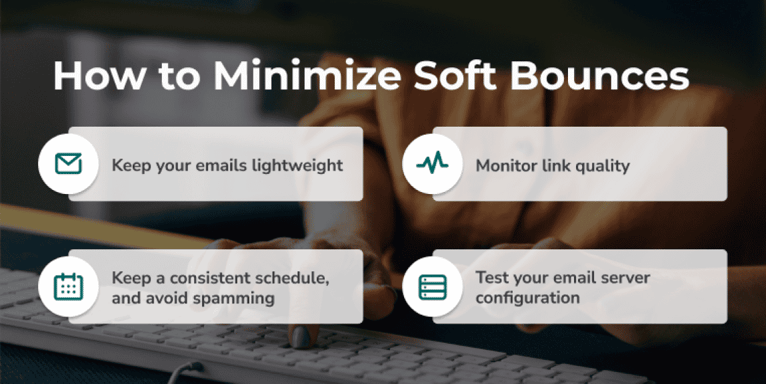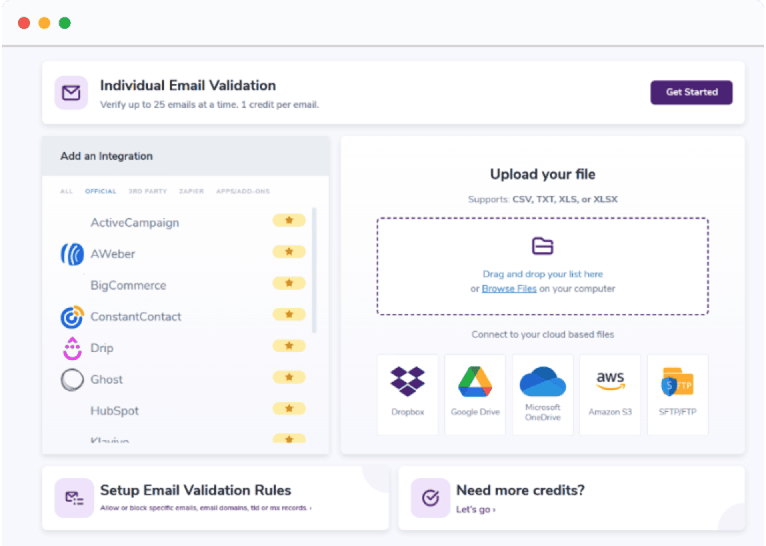Correos electrónicos rebotados
Por qué sucede y cómo evitarlo
¿Su tasa de rebote de correo electrónicoⓘEl porcentaje de correos electrónicos que no se entregan frente a los que se entregan al destinatario previsto. afecta sus campañas?
Conozca los tipos de rebote de correo electrónico y la forma en que perjudican su rendimiento, y sepa qué puede hacer para reducir la tasa de rebote ya mismo.

Los correos electrónicos rebotados no son solo una molestia. Pueden sabotear rápidamente todas sus iniciativas de marketing por correo electrónico y difusión "en frío".
Pero... ¿qué hace que un correo electrónico rebote?
Antes de que podamos explorar el "porqué", echemos un vistazo a los dos tipos de rebote de correo electrónico para comprender mejor la mecánica involucrada en el envío de un mensaje.
Explicación de los tipos de rebote de correo electrónico
Hay dos tipos de rebotes de correo electrónico:
- Rebote suaveⓘLa incapacidad de entregar un mensaje de correo electrónico, causada por factores temporales, como un buzón de correo lleno o medidas de inclusión en listas grises. - Algunos errores temporales, como una casilla llena o un tiempo de espera, provocan rebotes de correo "suaves".
- Rebote duroⓘLa incapacidad de entregar un mensaje de correo electrónico, causada por uno o más factores permanentes, como una dirección de correo electrónico no válida. - Los rebotes de correo electrónico "duros" se producen cuando hay un error permanente; por ejemplo, cuando se intenta enviar un correo a una dirección no válida o a un dominio no válido.
Ambos tipos de rebote influyen en la tasa de rebote general de su campaña. Es esencial controlar las tasas de rebote de su campaña para que se pueda detectar un aumento inesperado o inusual en los rebotes y tomar medidas antes de que cause daños duraderos en su dominio o IP. Tanto los rebotes suaves como los duros pueden tener un impacto negativo en el rendimiento de su marketing por correo electrónico.
¿Cómo afectan los correos electrónicos rebotados el rendimiento del marketing por correo electrónico?
Los correos electrónicos rebotados son una fuerte amenaza para el rendimiento y el retorno de la inversión de su marketing por correo electrónico.
La razón es simple: no puede generar interacción y conversiones si su correo electrónico no llega a alguien. Sin embargo, la amenaza de las altas tasas de rebote no se limita a la campaña. Los correos electrónicos rebotados continuos a lo largo del tiempo tienen un impacto negativo en su reputación y en su calificación como remitente.
Su reputación es lo que los proveedores de servicios de Internet y correo electrónico (ISP y ESP, respectivamente) toman como referencia para determinar la confiabilidad de un remitente de correo. El correo electrónico es utilizado a diario por personas malintencionadas que buscan engañar a los lectores con contenido de spam y estafas de phishing. A esos tipos de remitentes les importan poco las prácticas de envío seguro y, por lo general, tienen dominios y direcciones IP con tasas de rebote notoriamente altas. Si su empresa también tiene una alta tasa de rebote de correo electrónico, inmediatamente parecerá sospechoso, independientemente de lo que haya en sus correos.
¿Qué sucede cuando se ve perjudicada su reputación como remitente?
Los ISP y ESP reconocen los correos electrónicos que provienen de su dominio y es más probable que los filtren como spam automáticamente. También pueden rechazar sus correos directamente, lo que generaría otro rebote. Estas señales negativas continúan acumulándose y pueden dificultar, si no imposibilitar, que sus correos electrónicos lleguen de manera confiable a las casillas de entrada de sus suscriptores.
Su proveedor de servicios de correo electrónico también se dará cuenta. Los ESP más destacados, como Mailchimp o Zoho, aplican políticas estrictas con respecto a sus usuarios y las tasas de rebote de correo electrónico. Si tiene demasiados correos rebotados en una campaña o a lo largo del tiempo, pueden suspender su cuenta comercial, y lo harán.
Para resumir cómo afectan los correos rebotados el rendimiento del marketing por correo electrónico:
- Los correos electrónicos rebotados no pueden llegar a los clientesⓘEl acto de comunicarse con éxito con un cliente a través de un correo electrónico, mensaje de texto u otro medio de comunicación. para generar interacción y ventas
- Las altas tasas de rebote de correo electrónico dañan la reputación de su empresa como remitente
- A medida que su reputación se deteriora, la tasa de entrega de correos electrónicosⓘEl porcentaje de correos electrónicos que se entregan al destinatario previsto frente a los que no se entregan. disminuye y sus correos electrónicos terminan en la carpeta de spam
- Las altas tasas de rebote también indican otros problemas de envío, que pueden hacer que su ESP suspenda su cuenta
Cómo reducir la tasa de rebote de correo electrónico
Conocer bien los tipos de rebote nos brinda más información para identificar por qué puede producirse un rebote.
Cómo reducir los rebotes de correo suaves
Como los problemas temporales provocan un rebote "suave" de correos electrónicos, a menudo no están bajo su control y no puede evitarlo. Depende del propietario de la casilla o del proveedor de servicios solucionar los problemas que causan rebotes, como conexiones o casillas llenas. También existe una tecnología antispam llamada "lista gris", que rechaza temporalmente los correos electrónicos de nuevos remitentes durante un máximo de 15 minutos.

A continuación, le contamos cómo puede minimizar la cantidad de rebotes:
- Mantenga sus correos electrónicos ligeros - Utilice tamaños de archivo pequeños, especialmente cuando agregue imágenes o archivos adjuntos a un correo electrónico. Si el archivo es demasiado grande, puede causar problemas de tiempo de espera y provocar un rebote.
- Mantenga un cronograma regular y evite el envío de spam - A los ESP no les gusta que envíe demasiados correos electrónicos. Evite los rebotes suaves respetando un horario que sea óptimo para sus lectores.
- Controle la calidad de los enlaces - Al igual que en el caso de su sitio web, agregar enlaces de spam de baja calidad a un correo electrónico puede dañar su capacidad de entrega. Esté atento a lo que comparte con sus lectores.
- Pruebe la configuración de su servidor de correo electrónico - Un servidor de correo electrónico bien configurado con SMTP debería reintentar automáticamente la entrega si recibe un error 4xx (temporal). Esto es fundamental para cualquier causa de rebote temporal (suave), incluidas las medidas comunes de inclusión en listas grises. Si su servidor está configurado correctamente, debería volver a intentar la entrega automáticamente una vez terminado el período de lista gris, lo que le permitiría llegar a la casilla.
Cómo reducir los rebotes duros
Los rebotes duros de correo electrónico son una de las principales preocupaciones. Si registra un alto volumen de correos electrónicos con este tipo de rebote, generalmente se debe al uso de direcciones de correo electrónico no válidas o a un servidor de correo configurado incorrectamente.
A continuación, le contamos cómo puede reducir las tasas de rebote de correo electrónico:
![Cómo minimizar los rebotes duros: limpie su lista, utilice la suscripción doble, implemente la ,[object Object],, vaya preparando su reputación, pruebe sus correos electrónicos, utilice diferentes plataformas de correo y evite el spam.](https://www.zerobounce.net/cdn-cgi/image/fit=scale-down,format=auto,quality=90,width=766,metadata=none/static/bounced-emails-image-2.png)
Además, el spam también es determinado por sus patrones de envío. Envíe correos electrónicos en un patrón predecible (días y horas establecidos) para evitar activar filtros de spam.
¿Desea verificar una dirección de correo electrónico?
¡Eche un vistazo a nuestro evaluador de listas y verificador de correos electrónicos gratis!
Uso de los servicios de verificación de rebotes de correos electrónicos
La mayoría de las veces, un rebote duro de correo electrónico se produce debido a una dirección no válida. Tanto si se trata de un hecho aislado como si se siguen produciendo rebotes duros debido a una limpieza irregular de la lista, nunca es demasiado tarde para empezar.
A continuación, le contamos cómo puede incorporar herramientas de verificación de rebotes en su flujo de trabajo actual:
1. Descargue su lista de correo actual desde su CRM o proveedor de correo.
2. Cargue su lista en un servicio de verificación de correo electrónico. Cuando cargue su lista en ZeroBounce, automáticamente buscará cualquier duplicado en su lista y lo eliminará por usted.

3. Permita que el verificador de correos electrónicos verifique y valide sus contactos de correo. La duración dependerá del tamaño de tu lista, y se te notificará automáticamente por correo electrónico cuando se complete el proceso.
4. Descargue su nueva lista limpia de direcciones de correo electrónico. También recibirá un informe sobre qué direcciones de correo electrónico no son válidas o son de alto riesgo para tener una mejor idea del tipo de datos que está adquiriendo.
Los servicios de verificación de rebote son fáciles de usar y una forma económica de reducir drásticamente las tasas de rebote de correos. Para un remitente de correo electrónico o un especialista en marketing es una táctica fundamental que no se puede evitar hacer. Algunos ESP son tan estrictos con la limpieza de listas de correos electrónicosⓘEl proceso de eliminar correos electrónicos no válidos y de alto riesgo, como trampas de spam o correos electrónicos desechables, de una lista de correo electrónico. La limpieza de listas de correos electrónicos se puede realizar después de recopilar datos a través de la validación de correo electrónico. que pueden detectar inmediatamente cuando se han cargado datos malos en su plataforma si vieron esas direcciones o esa lista anteriormente.
Además de las cargas directas para la limpieza, estas son algunas formas adicionales en las que puede aprovechar los servicios de verificación de rebotes de correos electrónicos:
- Utilice una integración con su proveedor de correo, CRM o ESP: algunas plataformas de verificación de correos electrónicos ofrecen integraciones directas con muchas herramientas de marketing y ventas que usted ya utiliza. Actualmente, ZeroBounce cuenta con más de 60 integraciones.
Con una integración habilitada, puede sincronizar los contactos de su dirección de correo electrónico con la herramienta y limpiarlos automáticamente con poco esfuerzo. - Utilice una API de verificación de correo electrónicoⓘUna API, o interfaz de programación de aplicaciones, que permite que una herramienta de verificación de correo electrónico se conecte y se comunique con otra aplicación de software. en tiempo real: la mejor manera de reducir las tasas de rebote de correo electrónico es evitar la recopilación de datos no válidos en primer lugar. Si agrega un verificador de correos electrónicos en tiempo real a su sitio web, formularios de registro, páginas de destino o pantallas de pago, este detectará automáticamente las direcciones no válidas o riesgosas y las bloqueará. También es útil para detectar errores comunes, como errores tipográficos.
Contenidos
- para encontrar más detalles sobre los enlaces
- Explicación de los tipos de rebote de correo electrónico para encontrar más detalles sobre los enlaces
- ¿Cómo afectan los correos electrónicos rebotados el rendimiento del marketing por correo electrónico? para encontrar más detalles sobre los enlaces
- Cómo reducir la tasa de rebote de correo electrónico para encontrar más detalles sobre los enlaces
- Uso de los servicios de verificación de rebotes de correos electrónicos para encontrar más detalles sobre los enlaces
Preguntas frecuentes
Los rebotes en los correos electrónicos pueden deberse a errores temporales, como una casilla llena o el tiempo de espera del servidor de correo. También pueden deberse a un error permanente, como una dirección de correo electrónico no válida, que da lugar a un rebote duro.
Hay dos tipos de rebotes de correo electrónico: el rebote “suave“ y el rebote “duro“. Un rebote de correo electrónico suave se debe a algún error temporal, como una casilla llena. Se dice que el rebote de correo es duro cuando hay un error permanente, como el envío de un mensaje a una dirección de correo electrónico no válida.
Puede reducir las tasas de rebote de correo electrónico aplicando las prácticas recomendadas para el correo, como las siguientes: limpiar su correo electrónico para eliminar los correos no válidos, autenticar su dominio de correo electrónico, enviar en un horario regular y usar un proveedor de servicios de correo electrónico pago y confiable.
Si bien el impacto de un rebote suave no es inmediato, las altas tasas de rebote causadas por rebotes suaves continuos pueden afectar negativamente su reputación como remitente. Algunos errores, como los generados por una casilla llena o un servidor mal configurado, no están bajo su control. Sin embargo, puede mitigar los rebotes suaves limpiando su lista de correo electrónico, mejorando su reputación como remitente y asegurándose de que su servidor de correo esté configurado correctamente.